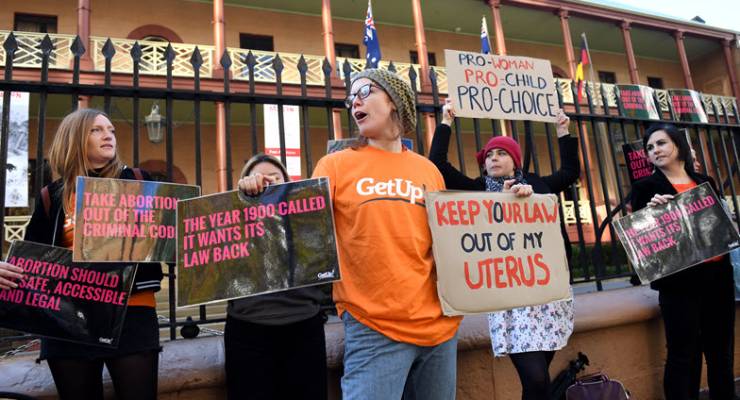
This week, news broke that NSW Premier Gladys Berejiklian was “absolutely” prepared to amend the state’s abortion bill to ban gender selective terminations.
This was something of a concession to the Coalition’s more conservative members, although the move has support from Labor leader Jodi McKay and, according to the Sydney Morning Herald, western Sydney Labor MPs. Opponents of the amendment have suggested that it could delay or prevent care for those seeking an abortion.
With the bill set to hit the upper house next week, Crikey looked at the evidence of gender selective abortions in Australia, what impact criminalising the practice has and whether all of this is the bad faith tactic it’s accused of being.
What’s the evidence?
Groups including the Australian Medical Association (AMA), Our Body Our Choices and the Human Rights Law Centre (HRLC) have argued that there is no substantial evidence for patients approaching doctors in Australia seeking gender-selective abortions.
There are anecdotal claims — a Melbourne doctor was investigated and cautioned by the Medical Board of Victoria in 2014 after refusing to refer a couple for an abortion (a legal requirement under Victoria’s Abortion Law Reform Act of 2008 for doctors with a conscientious objection to abortion) that he claimed was sex-selective — as well as a 2018 La Trobe University report into Victorian birth rates that’s the bill’s opponents suggest indicates a “gender bias” in births.
That study of 1.2 million births found that, while the state remained consistent with the standard ratio — 105 male babies born to every 100 females — the numbers skewed disproportionately male if the mothers were originally from China or India.
However, researchers noted they could not draw any conclusions about either contributing factors or the individual contribution of terminations, and highlighted another possibility: that parents were travelling overseas for gender-selective IVF treatments, using technology that is banned in Australia. This has not stopped anti-choice proponents from seizing on the study as evidence of gender selective abortion.
“The La Trobe study could not draw conclusions on the role of overseas assisted reproduction treatment and abortion,” says HRLC senior lawyer and reproductive rights expert Adrianne Walters. “But what it was clear on was the need for any responses to be focused on tackling the social and economic drivers of gender discrimination, which impact on all areas of women’s lives.”
What would a ban look like?
More importantly, there is no evidence that decriminalising abortions leads to sex-selective terminations. There is, however, plenty of data demonstrating that specifically outlawing sex-selective abortions does not work and significantly harms pregnant people — restricting access to healthcare, forcing doctors to police patients and encouraging racial and cultural profiling.
Nothing like the proposed NSW amendment exists in Australia, but there are bans across certain US states. A 2014 University of Chicago study found that bans in Pennsylvania and Illinois had no impact on birth sex ratios.
Additionally, the World Health Organisation and United Nations agencies also put out a joint statement in 2011 declaring that limiting health services like abortion in the name of banning sex-selection is more likely to lead to harmful impacts and “may put their health and lives in jeopardy”.
There is global evidence for sex-selective abortions, particularly in countries like China, India and South East Asian countries, where there are societal pressures valuing boys over girls. Further, fertility service providers in Australia have called for governments to allow sex selection for “family balancing”.
Either way, policing a health service would invariably shift a burden onto doctors — who the AMA argues would be forced to become “mind-readers” to ensure that patients are not secretly terminating due to gender concerns — and patients. A ban would also invariably target people of colour seeking abortions.
“The obligations on a doctor would be unclear, and I can’t see how a ban could operate in any other way but to put doctors in the position of policing their patients, second-guessing their decision making, and, in some cases, using inappropriate considerations to second-guess what their patient’s reasons might be,” says Walters.
“The marginalisation and stereotyping of women from culturally and linguistically diverse communities is a particular concern — you only need to look at the way this topic was spoken about in parliament last week to see this.”
Gender equality (but only in the womb)
What is missing from the debate is that the oft-cited La Trobe study actually made no
The bill as it stands, according to Walters, would severely police the bodies of women and trans-people.
“This is a really well-known tactic of people and groups that oppose abortion: to jump onto an emotive issue as a way to limit women’s access to abortion overall,” says Walters








Well – abortion, termination before independent existence at the beginning of life. Euthanasia, termination when dependant at the end of life – does this give a new meaning to Armenian genocide ?
Well – abortion, termination before independent existence at the beginning of life. Euthanasia, termination when dependant at the end of life – does this give a new meaning to Armenian genocide ?
It’s utterly unenforceable unless the person/couple seeking the termination are stupid enough to disclose it, so it’s the perfect sop for Gladys to give the religious wing of the LNP.
This will be difficult to enforce. People can just lie. Why add another obstruction. This is a health issue and has no place in the criminal code. Women must have the right to control their reproductive health using high quality, accessible professional services. If anyone would like to know about the good old days, read The Racket by Gideon Haigh.
Seems to ignore basic biology. If parents have one male child with hemophilia and genetic testing determines that a second child will express the same disease what then.?
Recessive disorders
The following principles generally apply to recessive disorders determined by a recessive X-linked gene:
Nearly everyone affected is male.
All daughters of an affected male are carriers of the abnormal gene.
An affected male does not transmit the disorder to his sons.
Females who carry the gene do not have the disorder (unless they have the abnormal gene on both X chromosomes or there is inactivation of the other normal chromosome). However, they transmit the gene to half their sons, who usually have the disorder. Their daughters, like their mother, usually do not have the disorder, but half are carriers.
An example of a serious disease caused by an X-linked recessive gene is hemophilia, a disorder that causes excessive bleeding.
There is also the problem of Sex Limited Inheritance that needs to be allowed for.
There is a case for eugenics now we have the accuracy of DNA- eugenics was all the scientific fashion in the early 1900s.
These decisions are way too personal for either the State or Religion to intervene as a decision determiner. It can only be the prospective parents acting with informed medical advice and if the prospective parents can’t agree then ultimately it is the woman’s reproductive organs in play and that’s where the final decision and responsibility lies and one that is deeply felt.